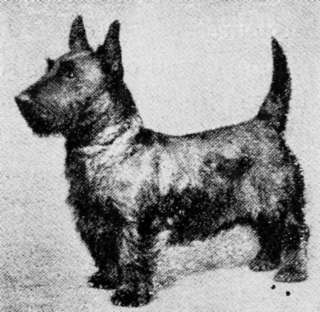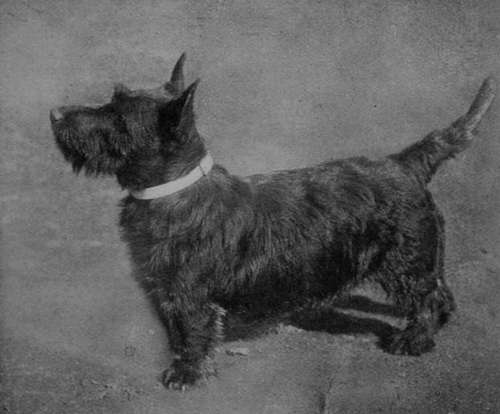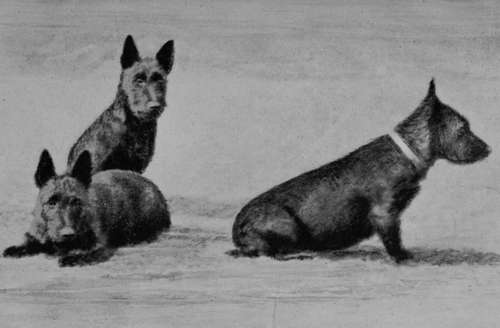The Scottish Terrier
Description
This section is from the book "Sporting Dogs. Their Points And Management In Health, And Disease", by Frank Townend Barton. Also available from Amazon: Sporting Dogs; Their Points and Management in Health and Disease.
The Scottish Terrier

Sometimes spoken of as the " Die-hard," a name said to have been given to them by George, Earl of Dumbarton, owing to the pluck of a pack owned by him.
The title is certainly not a misnomer, these little Terriers of Highland descent still having the gameness of their ancestors, though many of them at the present time are only used as ladies' companions.
The terms " Aberdeen " and " Scottish " Terrier are—or should be—synonymous, though an inferior specimen of a " Scottie" has, and is, frequently sold to the unwary as an "Aberdeen." Another name is that of " Cairn" Terrier, which speaks for itself, these dogs having been expressly bred for hunting in the cairns, or spaces amongst heaps of rocks, etc.

Scottish Terrier Dog Champion Hyndman Thistle.

A Trio of Scottish Terriers (Property of Mr M'Candlish).
Owing to their small size, they are admirably adapted for such purposes. Some will retrieve and take well to water; are good companions, and active house dogs. They are very hardy, consequently puppies are not difficult to rear, and fair specimens of the last-named can be had at two and three guineas apiece.
The following are the chief points of the Scottish Terrier.
Coat
In point judging, 20 per cent, of the marks are allotted to the coat—so many are faulty in this respect. Outer coat must be very thick, short, and of a hard or wiry texture, and absolutely free from any sign of curl, or waviness.
Hair
2 or 3 inches in length. Under coat, very dense.
The so-called " open " coat is a fault. The term is sufficiently explanatory.
Weight
From 14 to 20 lbs. for dogs and a few pounds less for bitches.
Colour
Not of great importance, but white markings are objectionable; less important on the breast, but better without any white hairs.
White specimens are rare.
Brindle, black, red, mustard, and iron-grey, are the usual colours, the black and brindle shades being-preferred.
Body
Important (value 10). This should be short, so as to give the dog a sturdy, compact appearance.
Some Scotties are too long in the body.
Neck
To be short and thick, ending in good, strong, sloping shoulders.
Chest
Deep, well-rounded on to the shoulders, and plump.
Limbs And Feet
Legs, short, big-boned, well-muscled, straight, though generally turned out at ankles, ending in large fore feet, and smaller well-padded hind ones. The same hard hairs should clothe the limbs. If soft, it is a fault.
Ears
Erect, or semi (half) erect. Must never " droop" at tips. Should be covered with short hair.
Particular attention is paid, by judges to the carriage of the ears of the Scottie.
Eyes
To be either dark brown or hazel, giving a lively expression to the face.
Head
Rather long, and wide above the eyes. Most of the length is gained from eyes to nose.
Hair to be hard and short (not soft).
Muzzle
Long, tapering, and very strong.
Sound teeth—exceptionally large—and tight lips are a sine qua non.

Group of Scottish Terriers (Property of Mr M'Candlish).
Height
9 to 12 inches.
Clubs
1. The English Scottish Terrier Society ; 2. Scotch Scottish Terrier Society.
Continue to:
